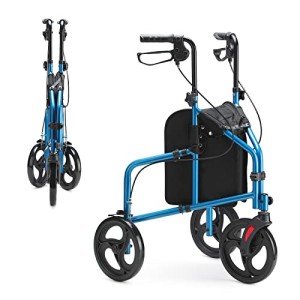
Walking Aids
Add a review FollowOverview
-
Founded Date September 24, 1986
-
Sectors Digital & Creative
-
Posted Jobs 0
-
Viewed 83
Company Description
What’s The Current Job Market For Handicap Walker Professionals?

Understanding Handicap Walkers: Types, Benefits, and Usage
Handicap walkers, likewise frequently understood as mobility walkers or simply walkers, function as essential aids for individuals with mobility obstacles. These devices supply physical support and stability, allowing users to stroll more confidently and individually. This short article explores the different kinds of handicap walkers, their benefits, and crucial factors to consider when choosing one.
What is a Handicap Walker?
A handicap walker is a device created to help people who have difficulty walking due to age, disease, or disability. Walkers assist users keep their balance, prevent falls, and recuperate mobility. Unlike canes, which provide very little support, handicap walkers typically offer a broader base of stability, making them ideal for more significant mobility challenges.

Kinds Of Handicap Walkers
Handicap walkers come in various designs, designed to fulfill the unique needs of users. Below is a breakdown of the most typical types:
| Type of Walker | Description | Suitable User |
|---|---|---|
| Standard Walker | A lightweight frame that requires lifting to move. Normally has rubber ideas for traction. | Those who can raise the walker and have moderate balance issues. |
| Wheeled Walker | Functions two wheels at the front, permitting for easier mobility without lifting. | Users who can keep stability and require more assistance while walking. |
| Rollator Walker | Comparable to wheeled walkers however includes hand brakes and a seat for resting. | Individuals needing a portable resting option with improved mobility. |
| Bariatric Walker | Specifically designed for heavier people, offering enhanced frames and larger hand grips. | Much heavier users requiring additional assistance and stability. |
| Kid Walker | Personalized models for kids to aid in their advancement and mobility. | Kids with developmental delays or mobility obstacles. |
Benefits of Using a Handicap Walker
Numerous users find that handicap walkers significantly improve their lifestyle. Here are some benefits:
1. Increased Stability
Handicap walkers supply a sturdy support structure, which assists avoid falls and improves users’ self-confidence when moving around.
2. Enhanced Mobility
Walkers make it simpler for people with mobility restrictions to browse stairs, uneven surfaces, and other challenging environments.
3. Independence
Utilizing a walker enables individuals to perform everyday activities separately, whether it’s walking around your home or shopping.
4. Pain Relief
Walkers enhance posture and distribute weight more equally, potentially reducing discomfort in joints and muscles during movement.
5. Social Engagement
By facilitating mobility, walkers permit users to get involved more actively in social events, household gatherings, and community activities, fostering a sense of belonging.
Essential Considerations When Choosing a Walker
Selecting the best handicap walker is crucial for making sure safety and convenience. Below are essential factors to consider:
-
User’s Height: Walkers can be found in different heights. It’s necessary to choose one that allows the user to stand upright with a slight bend in the elbows when keeping the handles.
-
Weight Capacity: Assess the weight capacity of the walker, particularly for bariatric choices, to guarantee it suits the user’s needs.
-
Portability: If the walker will be utilized often in different locations, think about models that can be quickly folded or carried, such as rollators.
-
Features: Some walkers consist of additional functions like cushioned seats, storage baskets, and adjustable handles. Assess which functions are most beneficial for the user.
-
User Preferences: The individual’s comfort and preferences ought to likewise play a significant function in the selection. Testing different designs might help determine the very best fit.
How to Use a Handicap Walker Effectively
Using a handicap walker properly ensures safety and maximizes its benefits. Follow these actions for safe use:
- Adjust the Height: Make sure the walker is adjusted to the appropriate height for the user.
- Stabilize the Walker: Place the walker in front while making sure all 4 rubber pointers or wheels touch with the ground.
- Use Proper Techniques: Move the walker forward about one action length, and then step into the walker while keeping the weight balanced.
- Preserve Good Posture: Stand straight and use the walker for support, not leaning excessively on it.
- Practice Regularly: Encourage users to practice walking with the walker frequently, helping to construct confidence and enhance balance.
Frequently Asked Questions (FAQs)
1. What is the difference between a basic walker and a rollator?
Standard walkers require the user to raise them with each action, while rollators have wheels and permit the user to press them forward without lifting. Rollators likewise normally consist of brakes and might have a seat.
2. Are handicap walkers covered by insurance coverage?
Coverage for handicap walkers can differ based upon an individual’s insurance plan. It is suggested to contact the service provider for particular information regarding protection and any necessary documents needed.
3. Can children use handicap walkers?
Yes, there are walkers developed particularly for children that accommodate their developmental requirements. It’s important to pick a model that is age-appropriate and supplies the necessary assistance.
4. How do I maintain my walker?
Regularly check the walker for wear and tear, consisting of the grips and wheels. Tidy the walker as needed and make sure all parts are functioning correctly for safety.
5. When is it time to stop utilizing a walker?
This differs by individual. Users need to seek advice from their doctor to assess mobility improvements and go over whether transitioning to a various mobility aid or moving without support is proper.
A handicap walker can be a transformative tool for people with mobility difficulties, providing them greater stability, independence, and enhanced quality of life. By understanding the various types, benefits, and key considerations in picking a walker, individuals can make informed options that line up with their unique needs and lifestyle. Whether for rehabilitation, aging gracefully, or managing disabilities, handicap walkers play a vital function in promoting mobility and well-being.
